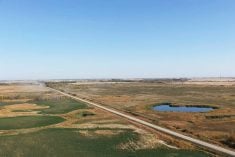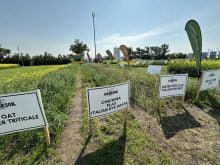Warm and relatively dry weather has allowed many producers to return to the field following last week’s rain delay. Seventy-four per cent of the crop is now in the bin while 19 per cent is swathed or ready to straight-cut, according to Saskatchewan Agriculture’s weekly Crop Report. The five-year (2010-2014) average for this time of year is 71 per cent combined and 20 per cent swathed or ready to straight-cut.
Regionally, producers in the southeast are furthest advanced, having 88 per cent of the crop combined. Producers in the southwest have 85 per cent combined. Seventy per cent of the crop is combined in the west-central region; 66 per cent in the east-central region; 57 per cent in the northwest and 59 per cent in the northeast.
Read Also

Claas brings 1000 Series SP forage harvesters to Canada
In mid-August, Claas unveiled its new line of Jaguar forage harvesters at an event in Visalia, California, deep in the heart of that state’s dairy region.
Eighty-seven per cent of the mustard, 79 per cent of the durum, 77 per cent of the barley, 72 per cent of the spring wheat, 70 per cent of the canola, 46 per cent of the soybeans and 33 per cent of the flax have been combined.
The majority of the province did not receive any rainfall this past week. Provincially, topsoil moisture conditions on cropland are rated as five per cent surplus, 86 per cent adequate, eight per cent short and one per cent very short. Hay land and pasture topsoil moisture conditions are rated as three per cent surplus, 76 per cent adequate, 18 per cent short and three per cent very short.
Many areas received frost this past week, although damage is minimal in most cases as crops were mature. Weather-related quality issues continue to cause concern in most areas. While overall yields are reported to be about average, they vary from region to region.
The Ministry of Agriculture has a Forage, Feed and Custom Service listing for producers to advertise and source feed products.
To read the full report, with a complete breakdown of crop districts, visit the Government of Saskatchewan website.















